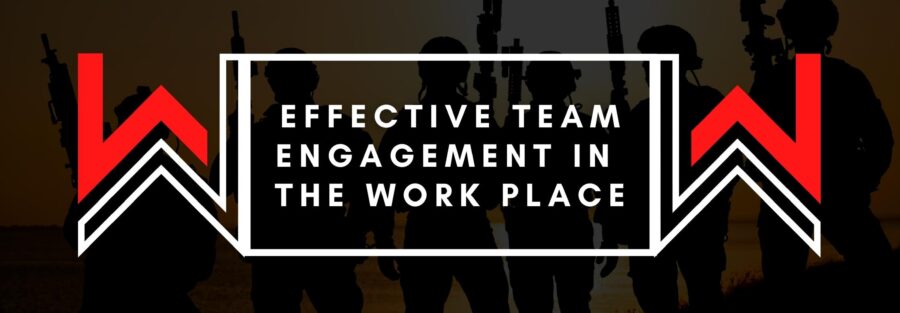EFFECTIVE TEAM ENGAGEMENT IN THE WORKPLACE AND HOW IT’S IMPORTANT TO BUSINESS LEADERSHIP
Effective team engagement starts with building a strong team culture. This can be done by clearly communicating the team’s goals and values, and by fostering a sense of trust and collaboration among team members. Team leaders can also promote engagement by recognizing and rewarding good work, and by providing regular feedback and opportunities for growth and development.
Another key strategy for engaging team members is to empower them to take ownership of their work. This can be done by delegating tasks and responsibilities, and by giving team members the autonomy to make decisions and solve problems. By giving team members a sense of purpose and ownership, they will be more motivated to take an active role in the team’s success.
In addition, effective communication is a vital component of team engagement. It’s important for team leaders to actively listen to team members and encourage open and honest communication among all team members. Also, Regular team meeting, team building activities and socialization opportunities can help in building trust and communication among the team members.
Another key factor is to create a positive and inclusive work environment. This can be done by fostering a culture of respect and diversity, and by creating opportunities for team members to get to know one another on a personal level.
Effective team engagement also involves managing conflict effectively. It’s important for team leaders to provide a safe environment where team members can express their opinions and ideas, and work through conflicts in a constructive manner. Also by providing team member with effective conflict resolution skills.
Finally, the most important principle in team engagement is that there is no single “right” way to engage team members. The best approach will depend on the unique characteristics of the team and the organization, and what has been found to work in the past. Continuously measure engagement, get feedback from team members and iterate to improve engagement level.
Those are some of the key principles and strategies for effective team engagement that you can use as a foundation for your research and writing. Remember that engaging a team is a continuous process and need regular attention, but with the right mindset, strategies, and tools, you can create an engaged and high-performing team that is well equipped to achieve its goals.
Recent Posts
- Mental Health in the Workplace: Fostering a Supportive and Productive Environment
- Understanding the factors that influence engagement
- Maximize Your Online Earning Potential with Remixable: The Ultimate Platform for Content Creation and Affiliate Marketing
- From Battlefields to Boardrooms: Navigating the Civilian Workforce for Military Veterans
- Why Veterans Make Exceptional Entrepreneurs
Great books on Amazon to read about communication and leadership
How clear communication with your team is vital.
Clear communication is a vital component of building a strong team culture. It helps to ensure that all team members are on the same page and have a shared understanding of the team’s goals, values, and expectations.
When team leaders communicate effectively, team members feel more informed and engaged in the team’s work. This can lead to a more positive and productive work environment, as well as better decision-making and problem-solving.
Clear communication can be achieved through a variety of methods, such as regular team meetings, one-on-one conversations, and written updates. Team leaders should make a conscious effort to be transparent and open in their communication, and to actively listen to and incorporate feedback from team members.
It’s also important for team leaders to establish clear channels of communication, such as an internal team website or chat platform, where team members can easily access important information and communicate with one another.
Effective communication should be two-way, meaning both team leader and members should be able to express themselves and listen actively to others. This helps in building trust among team members, which is a cornerstone of a strong team culture.
In addition, clear communication should be consistent, meaning it should be delivered at regular intervals, providing team members with regular updates and progress reports. This allows team members to stay informed about the team’s progress and adjust their work accordingly.
Overall, clear communication is a critical component of building a strong team culture. It helps to ensure that all team members are working towards the same goals, and that they have the information they need to be productive and engaged in their work.
How Fostering trust and collaboration is important.
Fostering trust and collaboration among team members is an important aspect of building a strong team culture. Trust is the foundation of any healthy team relationship and it is essential for effective communication, cooperation, and problem-solving.
One way to foster trust among team members is by being transparent and consistent in your communication and actions. When team members see that their leaders are open and honest with them, they are more likely to trust and believe in them.
Another way to build trust is by being reliable and dependable. Team members need to know that they can count on each other, and that they can trust their teammates to meet their commitments and follow through on their responsibilities.
Team building activities and socialization opportunities outside of work can also help to foster trust and collaboration among team members. These activities can help team members get to know one another on a personal level and build stronger relationships, which can then be transferred to the work environment.
Sharing success and failures as a team, and celebrating together can also help to foster trust and collaboration. When team members feel a sense of shared ownership and accomplishment, they are more likely to work together to achieve common goals.
Clear delegation of responsibilities and empowering team members to make decisions can also foster trust and collaboration. When team members feel that they have a meaningful role to play in the team’s success, they are more likely to trust their teammates and work together to achieve common goals.
Finally, it’s important for team leaders to be effective in conflict resolution. By creating a safe and open environment where team members feel comfortable expressing their opinions and ideas, and by facilitating constructive discussions, team leader can help to build trust and collaboration among team members.
Overall, fostering trust and collaboration among team members is crucial for building a strong team culture. It requires consistent effort from team leaders and team members, but when done effectively, it can lead to increased productivity, better decision-making, and a more positive work environment.
Recognizing and rewarding good work is important to your team and its members.
Recognizing and rewarding good work is an important aspect of engaging team members and building a strong team culture. It helps to motivate team members and encourages them to continue to put in a strong performance.
There are several ways to recognize and reward good work:
-
Verbal recognition: Team leaders can give team members verbal praise and recognition for a job well done. This can be done in team meetings, one-on-one conversations or even through an instant messaging platform.
-
Written recognition: A written note, email or a letter of appreciation can also be a great way to recognize and reward good work. This can be kept as a record and can also serve as a source of motivation for the team member.
-
Rewards and incentives: Monetary and non-monetary rewards and incentives can also be used to recognize and reward good work. This can include things like bonuses, gift cards, or time off.
-
Public recognition: Public recognition such as announcing the achievement in team meetings, company-wide emails or even in an internal company newsletter can also be a great way to recognize and reward good work.
-
Opportunities for growth and development: Providing team members with opportunities for growth and development, such as training programs or stretch assignments, can be a powerful way to recognize and reward good work.
It’s important to keep in mind that recognition and rewards should be specific, timely, and meaningful. The recognition should be specific to the individual and the work they have done, and should be given as soon as possible after the achievement. It’s also important to tailor the recognition and rewards to the individual team member, as different people have different preferences.
It’s also important for team leaders to be consistent in recognizing and rewarding good work. By recognizing good work on a regular basis, team leaders can create a culture of accountability and excellence, and encourage team members to continue to perform at a high level.
Overall, recognizing and rewarding good work is an essential aspect of engaging team members and building a strong team culture. It helps to motivate team members and encourages them to continue to put in a strong performance.
Providing feedback and opportunities for growth and development to facilitate on going motivation to your team and employees.
Providing feedback and opportunities for growth and development is an important aspect of engaging team members and building a strong team culture. It helps team members to understand their strengths and areas for improvement, and gives them the chance to develop the skills they need to be successful in their roles.
There are several ways to provide feedback and opportunities for growth and development:
-
Regular performance evaluations: Team leaders can conduct regular performance evaluations to provide team members with feedback on their performance. This can be done through one-on-one meetings, written evaluations, or through a formal performance management process.
-
Ongoing feedback: Team leaders should also provide team members with ongoing feedback throughout the year. This can be done through regular check-ins or informal conversations. This type of feedback allows team members to receive guidance in real-time and make adjustments on the spot.
-
Training and development programs: Team leaders can also provide team members with opportunities for growth and development through training and development programs. This can include things like workshops, seminars, or online courses.
-
Stretch assignments: Team leaders can also provide team members with stretch assignments, which are tasks or projects that are slightly outside of their current skill set. This allows team members to learn new skills and develop their capabilities.
-
Mentoring and coaching: Team leaders can also provide team members with mentoring and coaching opportunities. This can include pairing team members with more experienced colleagues who can provide guidance and support.
It’s important to keep in mind that feedback and opportunities for growth and development should be delivered in a constructive and supportive manner. Feedback should focus on specific behaviors or actions, and should be given in a way that is respectful and supportive.
Opportunities for growth and development should be tailored to the individual team member and their specific needs and goals. Team leaders should work with team members to understand their career aspirations and help them to develop a plan for achieving their goals.
Overall, providing feedback and opportunities for growth and development is an essential aspect of engaging team members and building a strong team culture. It helps team members to understand their strengths and areas for improvement, and gives them the chance to develop the skills they need to be successful in their roles.
Our fellow patrons will receive access to receive tons of helpful things like:
- How to analyze a company and its’ financials to determine whether it’s a good investment
- Exclusive Invite Only Scripts and Coding for TradingView that I use personally and for my hedge fund!
- Fundamental Education & Resources
- Technical Education & Resources
- Weekly Mentorship w/ Lessons (Valued $25,000+)
- Free eBooks and Courses along with other Valuable Resources (Valued $10,000+)
- Access to Q&A’s Daily along with Nightly Sessions
- Learn How to Read the Charts and Candles
- Learn How to Use Technical Analysis
- Learn How to Read Financial Documents
- Random Prizes!
- Network with Others like you!
- And so much more!






